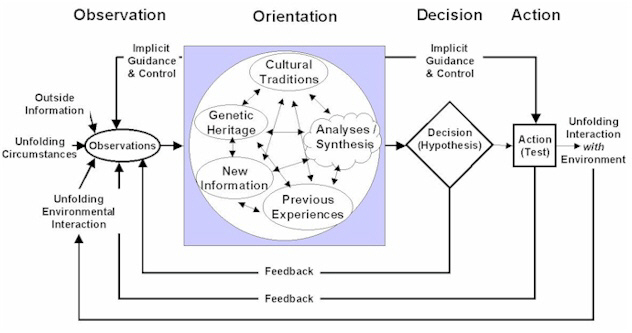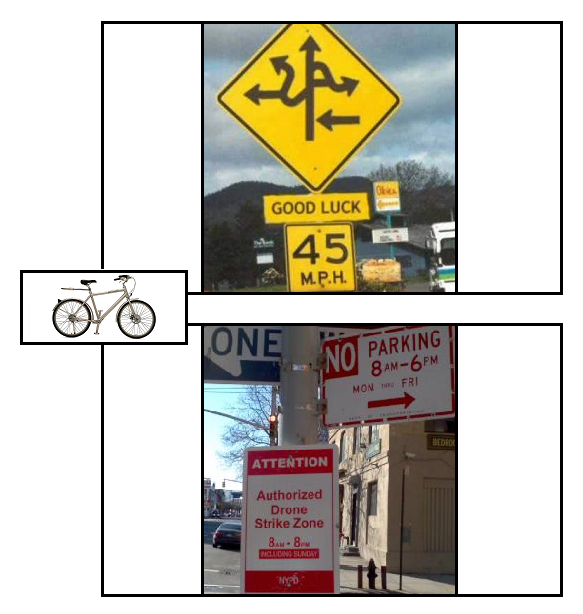John Robb at Global Guerrillas had a nice primer on John Boyd’s OODA Loop recently and he put on a twist that I thought was very useful:
HOW TO WIN ANY CONFLICT
….I’m Inside Your OODA Loop
How does all of this apply to conflict? The simple answer is that conflict, in its most basic form, is a contest between decision making loops. The side with the FASTER and BETTER decision making loop wins any conflict. Why? They adapt quicker. Here’s some more detail:
A FASTER decision making loop means that you accomplish a successful OODA loop quicker than an opponent. If you can do this, you are inside your opponent’s OODA loop. This means that by the time your opponent responds to your  last actions, you are already onto your next ones. Get far enough ahead and the opponent’s decision making process will collapse and victory is assured.
last actions, you are already onto your next ones. Get far enough ahead and the opponent’s decision making process will collapse and victory is assured.
A BETTER decision making loop? That’s question that can lead to endless debates and theory crafting. My approach to improving a decision making loop? Connectivity. The more connected a loop is, the better the decision loop is. Connectivity falls into three categories:
- Mental — improves decisions by connections to a superior mental model of the current situation. A superior model/strategy is predictive of events. It can tell you what data is important and what isn’t. Weak strategies/tactics fall apart upon first contact w/enemy.
- Physical — improves observation through connections to better sources of data, cleaner w/less distortion — improves action by making it possible to actually accomplish the desired decision in the real world
- Moral — better orientation due to connections to strong traditions, extensive experience, and collected wisdom. Training can help here.
The opposite is true also. Damage an opponents connectivity, and their decision making loops are less effective.
One of the difficulties with discussing OODA is that many people who either oppose the concept or do not know much about it, will explain the OODA Loop only as “getting inside your opponents OODA Loop” in terms of the capacity to “go faster” -i.e cycle through your own OODA Loop faster than your opponent, making more decisions, taking more actions, leaving them in the dust, disoreinted and going into a downward spiral to defeat. Usually, misrepresented like this:

Ok, well going “faster” is a small part of it, but not sequentially and there’s neurological limits on this that arrive pretty quickly in terms of thinking speed in any case. Robb’s use of “BETTER” helps capture more of the critical and subtle qualitative nature of the “Orientation” box:

What are some of the possible effects of a “virtuous cycle” of better decisions?
Position yourself with more options
Gain new perspectives (“Observation”, “Orientation”)
Position yourself with the greatest comparative advantage (best option)
Lock in a comparative advantage
Position yourself with the longest potential decision tree (no quick “dead ends” or “cul de sacs”)
Change the tempo of interaction in your favor
Change the rules of interaction in your favor
Prevent a conflict with additional potential oponents
Lower your costs or increase theirs
Assure minimum gains
Arrive first
Increase or decrease the distance between yourself and your opponent
Broaden or narrow the field of conflict
Gain time
Seize or maintain the initiative
Define or redefine “victory”
Foreclose a critical option or set of options to your opponent
Force your opponent to act on your terms (“Check”)
Lower the morale of your opponent
Confuse, mystify or mislead your opponent
Attract allies or supporters
Increase your resources or potential maximum gains
Repair, remediate or replace previous losses
John is correct that “connectivity” helps you gain many of these benefits.
Remember:
“Being on the winning side is a lot more fun!”
ADDENDUM (Some interesting commentary on OODA):
Adam Elkus
I’ve Got the OODA Blues
Joseph Fouche:
Libeling Boyd
How Not to be Like Boyd
Who’s Afraid of Genghis John?
TDAXP, PhD
Variations of the OODA Loop 1: Introduction
Variations of the OODA Loop 2: The Naive Boydian Loop
Variations of the OODA Loop 3: The Sophisticated Boydian Loop
Variations of the OODA Loop 4: Pseudo-Boydian Loops
Variations of the OODA Loop 5: Post-Boydian Loops
Variations of the OODA Loop 6: Bibliography



 last actions, you are already onto your next ones. Get far enough ahead and the opponent’s decision making process will collapse and victory is assured.
last actions, you are already onto your next ones. Get far enough ahead and the opponent’s decision making process will collapse and victory is assured.



